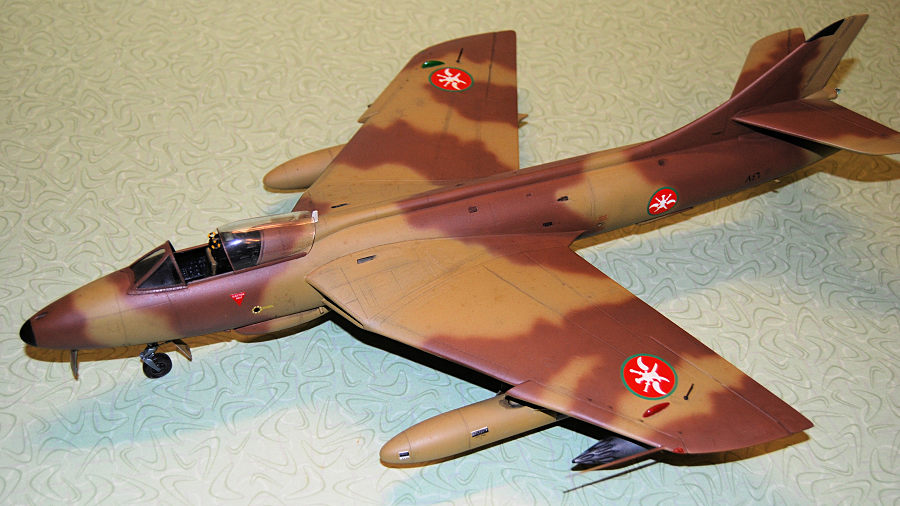
Revell 1/32 Hunter FGA.9
| KIT #: | 4670 |
| PRICE: | $35-50.00 |
| DECALS: | Two options |
| REVIEWER: | Christopher Campbell |
| NOTES: | One of the nicest 1/32 kits out there, straight out of the box |

| HISTORY |
Yes, ladies and gentlemen, the Hawker Hunter. Possibly the most aesthetically appealing jet fighter ever produced, The Hunter began life as series of design studies by Hawker maestro Sydney Camm, who had been instrumental in the design of numerous legendary Hawker aircraft. This included biplanes such as the Fury, Hart, Nimrod and associated aircraft as well if the Hurricane, Typhoon, Tempest, and Sea Fury. As the jet age dawned he gave the Fleet Air Arm the Sea Hawk. Then he would produce what could be viewed as his masterpiece, the glorious, beautiful Hunter.
Given low priority initially, the British government at the time considering that that the Meteors and Vampires already in service were sufficient, the growing Cold War tensions followed by the North Korean invasion of South Korea saw the Hunter given a greater priority than most other aircraft proposals and projects then under what could at best be called a very protracted development.
A competing project, the Supermarine Swift, was also kicked into high gear. Both showed great promise. Both would falter at times. It was the Hunter that would prevail, arguably the pinnacle of subsonic fighter aircraft. The Swift would be beset endless teething problems was accelerated the decline and fall of the once stellar Supermarine company. It had hardly entered service with the R.A.F. when it began being withdrawn in favor of the superior and more versatile Hawker design.
Designed around the Rolls-Royce Avon jet engine with 6,500 lbs. of thrust, problems were encountered early on. Not the least of these were frequent compressor stalls, often in conjunction with the cannons being fired. The Armstrong-Siddeley Sapphire was installed in an effort to remedy this. While possessing nearly 1,500 lbs. greater thrust and offering greater performance, the Sapphire proved to be fraught with troubles of its own and soon was abandoned in favor of a newer version of the Avon with an improved compressor that resolved most of its issues. The Sapphire would see service in the F.5 version, though all other production models would be powered by the Avon in one form or another.
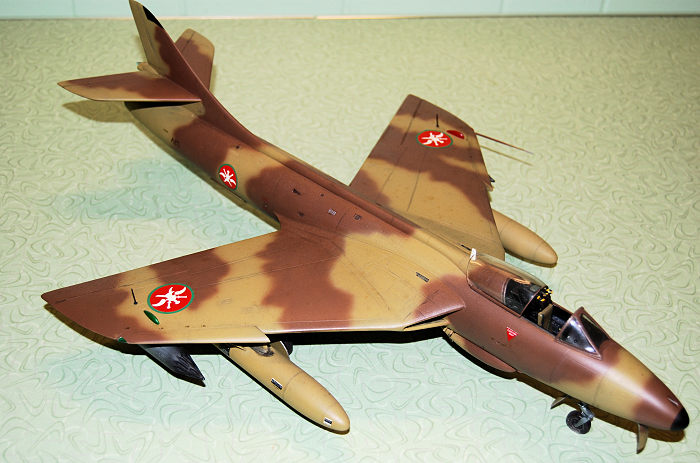 Another
problem came from its main armament. A quartet of 30mm Aden cannon packed a
powerful punch. As previously mentioned, the blast from the cannon tended to
cause compressor stalls when ingested by the intakes. Additionally, spent shell
links would slam into the aircraft causing damage to the ventral fuselage. These
issues were resolved with addition of special venting and most noticeable,
bulbous but streamlined bulges for link collection.
Another
problem came from its main armament. A quartet of 30mm Aden cannon packed a
powerful punch. As previously mentioned, the blast from the cannon tended to
cause compressor stalls when ingested by the intakes. Additionally, spent shell
links would slam into the aircraft causing damage to the ventral fuselage. These
issues were resolved with addition of special venting and most noticeable,
bulbous but streamlined bulges for link collection.
A variety of underwing stores could be carried. There was, of course, provision for external fuel tanks. A variety of rockets could also be carried both on racks and in pods. Bombs could also be carried in the air to ground role. Many export versions would also eventually carry AIM-9 Sidewinders and AGM-65 Mavericks. GAR-2 (AIM-4B) infrared heat seeking Falcons may sometimes have been carried by Swedish and/or Swiss Hunters, though I have not definitively confirmed this. Unfortunately, lacking anything more than sophisticated than a basic ranging radar, Hunters would never carry long rage guided missiles, though the versatile weapons suite available was still impressive.
The Hunter would enter service 1955 and would go on to one of the longest service careers of any aircraft, fighter or otherwise. It would first see action in the Suez Crisis one year later. It would remain in British frontline service for more than a decade. It continued in a secondary and training roles into the 1990’s. It would also be the mount of several R.A.F. aerobatic teams in striking paint schemes in the guise of the Black Arrows and Blue Diamonds and set several air speed records during its day.
In foreign service it would serve around the globe. In Europe, N.A.T.O. operators included Belgium, Denmark, and the Netherlands. It would also serve in the air forces of Sweden and Switzerland, the later keeping their in service until 1994.
In Asia, India would be a prolific user with aircraft seeing combat against the Pakistani Air Force in both 1965 and 1971 wars. India would retain their Hunters in service into the 1990’s as well. Likewise, Singapore would operate the Hunter for nearly thirty years, in to the same decade.
It would serve with the Peruvian and Chilean air forces in South America, also with very long careers. Chilean Hunters would see action in the 1973 coup. Also, most oddly they were used to ignite and oil spill from a grounded tanker in the same year, perhaps one of the most unorthodox, ill conceived, and counter productive attempts at purported environmental cleanup.
In Africa they would serve in Somalia, Kenya, Rhodesia, and its successor state, Zimbabwe. Somali Hunters would also see combat in strikes against rebel groups. Rhodesia would make extensive use of theirs in the Bush War. These aircraft were inherited by Zimbabwe and would again see action in support of Congolese loyalists during the Second Congo War. Reportedly, Zimbabwe still maintains some aircraft in service as of 2022.
It would be almost everywhere in the Middle East. Operated by Abu Dhabi, Iraq, Jordan, Kuwait, Lebanon, Qatar, and Saudi Arabia, Hunters would frequently be in action in border clashes and against internal rebels. Iraq and Jordan utilized them in the Six Day War with Israel. Most would have long service lives, by now, an obvious pattern for this amazing aircraft. The final ones in the region would be retired by Lebanon in 2014, sixty years after the first Hunter flew.
Many are preserved in museums worldwide. It also continues to fly today in civil hands as well, a number being used as chase planes, research aircraft and development aircraft, and in some cases under contract with agencies of various governments for various non-military needs. Several are operated as jet warbirds and also by air force commemorative flights. Tragically, on such bird was lost in an accident in 2015 in the U.K. when it crashed into a roadway during a low altitude loop, killing eleven.
This aircraft could be said to be the Methuselah of jet fighters. Nearly seventy years after its introduction into service, at least one country it seems still has them in service. It lives on as a warbird, and hopefully will for many years to come so yet more generations can see this beautiful jet take to the air.
As a footnote to this, shortly after I got this kit, I had gone for a walk with my parents in their neighborhood one day. This was one of the last times I would get to do so, as age was catching up with them. It was late in the afternoon on a summer day, and we heard a jet flying over. I had initially not looked up, presuming it to be an airliner.
Dad did, though, doubtless his years as and Air Force line mechanic rekindled by the familiar sound. Looking up, he asked, “What kind of fighter is that?”
I looked up and was astonished to see a Hawker Hunter heading North-West. It was the only Hunter that I had ever seen and was so stunned that it took a few moments for me to reply. None of us had ever seen one before, in flight or in a museum, so it was bit of treat.
I presume it was an aircraft on the “warbird” circuit, en route to an airshow somewhere. It was a beauty to behold in flight with the afternoon sun glinting off of it. Dad had served in Europe and North Africa during the 1950’s and noted that he had always heard about them, but never saw one.
I said something to the effect of, “I think it was one of the best looking jets ever built.” Dad nodded, responding, “It sure is that.” That summed it up well.
| THE KIT |
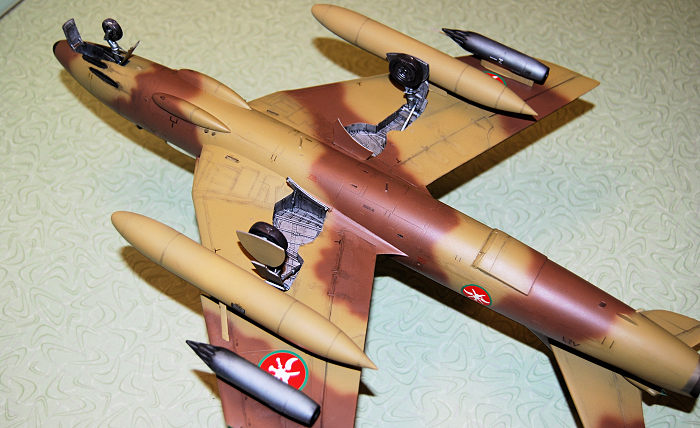 First
released in 1998, Revell’s Hunter kit is a bit of an out of box masterpiece. It
was released to much fanfare at the time, and equal adulation. Numerous decal
sheets, resin, and phot etch detail kits appeared in a perfect synchronistic
storm, allowing the modeler to build most any version of the legendary hunter
that their little heart desired.
First
released in 1998, Revell’s Hunter kit is a bit of an out of box masterpiece. It
was released to much fanfare at the time, and equal adulation. Numerous decal
sheets, resin, and phot etch detail kits appeared in a perfect synchronistic
storm, allowing the modeler to build most any version of the legendary hunter
that their little heart desired.
Then the odd, implausible, bordering on weird happened. Many bought it, few built it, and some even chose to lambast it. Yet, why?
The kit is well molded with very nicely recessed detail. The fuselage is designed with the nose as a separate part clearly implying that a trainer version that never appeared might be released (Though at least one aftermarket option was offered, as well as recon version). The kit came with numerous optional stores for attack/strike variants as well as standard fighters.
The cockpit is quite nice out of the box. While the parts are numerous, unlike some 1/32 scale kits, they are not needlessly so. So, why do we not see more of these built up.
That truly is a mystery. After having built this kit, I have very few complaints. It is not quite a “shake and bake” kit, though any modeler with a modicum of experience should be able to complete this kit with ease and to a fine representation of Hawker’s quintessential jet fighter.
| CONSTRUCTION |
nicely detailed throughout and fits very well. As some other write ups have
done, I am essentially going to hit the high points and one low here.
There are resin detail sets for the cockpit, but my general thoughts are: why? What comes out of the box is very nice. I painted everything in Tamiya Flat Black followed by dry brushing in Testor’s Silver to enhance details. Gauges were given a drop of Micro Kristal Kleer and various details painted popped with red, yellow, and green. I general wash was given to give it a used look and with that one has a very Hunter “office” as it were.
The nose is going to need a significant amount of weight. I solved this by using a wad of modeling clay with some #9 birdshot kneaded into it. This was crammed into the nose before everything was closed up.
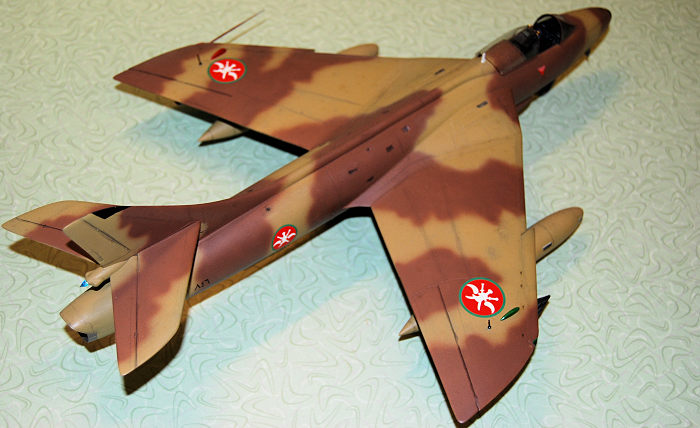 The only
place that I had any trouble at all was with the splitter plates in the intakes.
I managed to jack one up due to in no small part having far too many builds
under my belt. I got over enthusiastic with ease of the build and stopped
looking at the instructions at a time when I should have been. Thus, I missed
installing these when I should have.
The only
place that I had any trouble at all was with the splitter plates in the intakes.
I managed to jack one up due to in no small part having far too many builds
under my belt. I got over enthusiastic with ease of the build and stopped
looking at the instructions at a time when I should have been. Thus, I missed
installing these when I should have.
I did not notice my error until I was well along with the build. I had the entire fuselage and wings assembled, sanded, and nearly ready to paint when I suddenly noticed that I had omitted these parts. There were only two solutions: tear it apart or try to fit them through the intakes with CA glue and a pair of tweezers. Naturally, I chose the latter.
One went on perfectly. The other could never quite be aligned correctly, though I got it pretty close. DO NOT MAKE THIS MISTAKE! FOLLOW THE INTRUCTIONS! If you do, this should not happen and you should be able to build a near museum piece.
I never needed any actual filler in this build. Any filling was easily done with CA glue and most sanding was 320 through 400 grit followed by finishing with 0000 steel wool. I was a little worried by the look of the separate sections for the dog-tooth wing leading edges, but these fit without issue.
There are parts specific to the version of the Hunter that you are building. Many are for late Swiss aircraft that would not be applicable to earlier versions, so do a little research on the plane that you wish to build and be certain to use the correct ones.
| COLORS & MARKINGS |
I have always loved the national insignia of the Sultan of Oman’s Air Force. It is one of the most unique and striking insignia of any air force in the world and uniquely Middle eastern with its crossed curved swords and dagger. There have been several versions of the insignia used on the Hunter, including more modern, low viz versions. However, the classic insignia with its red field and green surround were the way to go with this one.
Unfortunately, I do not recall what decal sheet that I got these from and have been not found a reference to the sheet online. I do recall that they were a bit hard to find and I was most cautious in applying them, as I knew replacements would pretty much be a no go. However, I am a little bit ahead of my story.
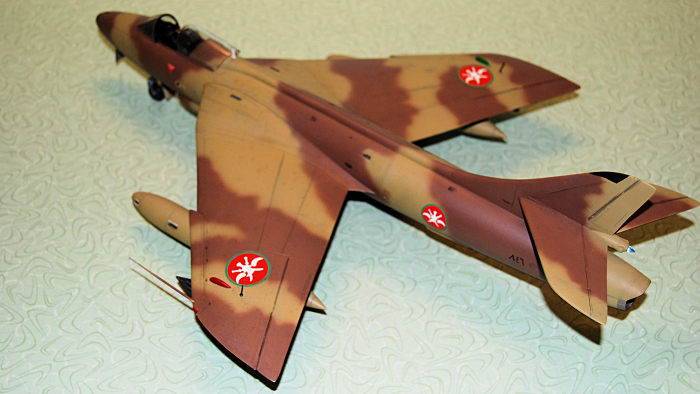 I started
out by preshading everything with Tamiya Flat Black. The landing gear bays were
then sprayed with Testor’s Aluminum and once dry all of the openings were
stuffed with damp paper towels. Then the whole thing was sprayed in Model Master
R.A.F. Middlestone. The wraparound camo of R.A.F. Dark Earth was then sprayed
freehand and everything looked right the first time around.
I started
out by preshading everything with Tamiya Flat Black. The landing gear bays were
then sprayed with Testor’s Aluminum and once dry all of the openings were
stuffed with damp paper towels. Then the whole thing was sprayed in Model Master
R.A.F. Middlestone. The wraparound camo of R.A.F. Dark Earth was then sprayed
freehand and everything looked right the first time around.
While this was drying the landing gear was painted in Model Master Dark Anodonic Grey with the compression struts painted in Model Master Chrome. The wheels were assembled and tires painted in Tetsors Rubber, with the wheels also taking Dark Anodonic Grey. These were then assembled and glued in place with CA glue. Once sitting on its “chassis,” so to speak, everything was given a coat of Model Master Gloss.
Once thoroughly dry, the decals were applied and settled down well with a little MicroSol. As mentioned, the roundels were carefully handled, but presented to problems. Data decals were taken from the kit supplied sheet and also performed well. The Arabic serial was taken from one of several Arabic number sheets in my decal file.
| FINAL BITS |
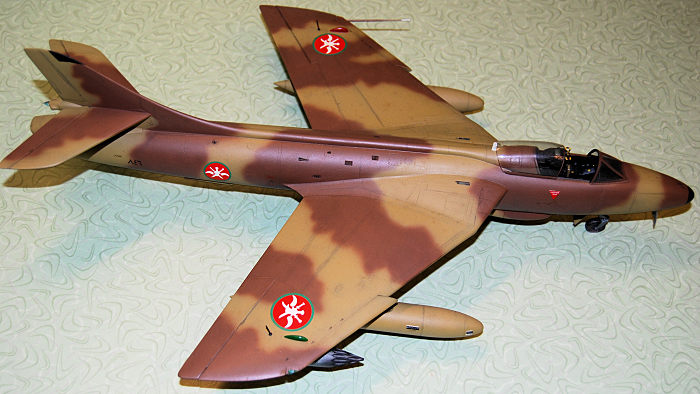 The external
fuel tanks were fitted, along with the landing gear covers, rocket pods, blade
antenna, and several other smaller, “fiddly bits.” The cannon ports were given
some weathering and moderate gunblast by drybrushing with Tamiya Flat Black. A
light wash of Tamiya Smoke was used to enhance some areas such as vents.
The external
fuel tanks were fitted, along with the landing gear covers, rocket pods, blade
antenna, and several other smaller, “fiddly bits.” The cannon ports were given
some weathering and moderate gunblast by drybrushing with Tamiya Flat Black. A
light wash of Tamiya Smoke was used to enhance some areas such as vents.
At this point, everything was sprayed in Model Master Flat an set aside. While this drying, I painted the framing on the canopy and gave it a light dunk in future. Once all was dry, this was glued in place with a light application with CA glue and I found the fit of the canopy excellent, just like most other parts of the kit.
The wing lights were tinted in Tamiya Clear Green and Clear Red. The tail light was tinted in their Clear Blue and all were glued in place with GS Watch Crystal Cement.
Whoa? Was this big beast actually done? It looked like it. I had to step back and check everything over to make certain hat I had not missed anything. Yet sure enough it was finished.
| CONCLUSIONS |
There is precious little one can find to fault with this kit. I spent around twenty hours or so on it, though none of this time can be traced to any faults with the kit. It is a big model with a lot of parts, though not the hair pulling number one might find in a Trumpeter kit. It takes a little time to and patience to build, but it is well worth the effort. It builds up into a beautiful model and I would recommend it to any fan of the Hunter with moderate experience. I have another in the stash to build up in Singaporean markings and I am looking forward to it.
| REFERENCES |
Hawker Hunter in Action, Aircraft no. 121, by Glen Ashley, 1992, Squadron Signal Books
Hawker Hunter F.1/T.66 in Royal Air Force & Foreign Service, By Richard Ward, 1971, Arco-Aircam Aviation Series
Hawker Hunter Super Profile by M.J. Hardy, Haynes Books, 1985
Hawker Hunter- The Complete History by Tim McClelland, Crecy Books, 2009
Hawker Hunter in Color by Robbie Robinson, Squadron Signal Books, 1986
https://en.wikipedia.org/wiki/Hawker_Hunter
Copyright ModelingMadness.com. All rights reserved. No reproduction in part or in whole without express permission.
If you would like your product reviewed fairly and fairly quickly, please contact the editor or see other details in the Note to Contributors.